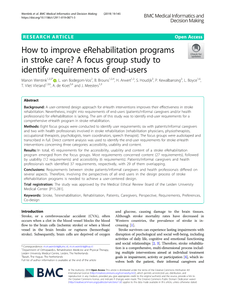Accurate modeling of end-users’ decision-making behavior is crucial for validating demand response (DR) policies. However, existing models usually represent the decision-making behavior as an optimization problem, neglecting the impact of human psychology on decisions. In this paper, we propose a Belief-Desire-Intention (BDI) agent model to model end-users’ decision-making under DR. This model has the ability to perceive environmental information, generate different power scheduling plans, and make decisions that align with its own interests. The key modeling capabilities of the proposed model have been validated in a household end-user with flexible loads
DOCUMENT

Background: A user-centered design approach for eHealth interventions improves their effectiveness in stroke rehabilitation. Nevertheless, insight into requirements of end-users (patients/informal caregivers and/or health professionals) for eRehabilitation is lacking. The aim of this study was to identify end-user requirements for a comprehensive eHealth program in stroke rehabilitation. Methods: Eight focus groups were conducted to identify user requirements; six with patients/informal caregivers and two with health professionals involved in stroke rehabilitation (rehabilitation physicians, physiotherapists, occupational therapists, psychologists, team coordinators, speech therapist). The focus groups were audiotaped and transcribed in full. Direct content analysis was used to identify the end-user requirements for stroke eHealth interventions concerning three categories: accessibility, usability and content. Results: In total, 45 requirements for the accessibility, usability and content of a stroke eRehabilitation program emerged from the focus groups. Most requirements concerned content (27 requirements), followed by usability (12 requirements) and accessibility (6 requirements). Patients/informal caregivers and health professionals each identified 37 requirements, respectively, with 29 of them overlapping. Conclusions: Requirements between stroke patients/informal caregivers and health professionals differed on several aspects. Therefore, involving the perspectives of all end users in the design process of stroke eRehabilitation programs is needed to achieve a user-centered design.
MULTIFILE

Introduction: Many adults do not reach the recommended physical activity (PA) guidelines, which can lead to serious health problems. A promising method to increase PA is the use of smartphone PA applications. However, despite the development and evaluation of multiple PA apps, it remains unclear how to develop and design engaging and effective PA apps. Furthermore, little is known on ways to harness the potential of artificial intelligence for developing personalized apps. In this paper, we describe the design and development of the Playful data-driven Active Urban Living (PAUL): a personalized PA application.Methods: The two-phased development process of the PAUL apps rests on principles from the behavior change model; the Integrate, Design, Assess, and Share (IDEAS) framework; and the behavioral intervention technology (BIT) model. During the first phase, we explored whether location-specific information on performing PA in the built environment is an enhancement to a PA app. During the second phase, the other modules of the app were developed. To this end, we first build the theoretical foundation for the PAUL intervention by performing a literature study. Next, a focus group study was performed to translate the theoretical foundations and the needs and wishes in a set of user requirements. Since the participants indicated the need for reminders at a for-them-relevant moment, we developed a self-learning module for the timing of the reminders. To initialize this module, a data-mining study was performed with historical running data to determine good situations for running.Results: The results of these studies informed the design of a personalized mobile health (mHealth) application for running, walking, and performing strength exercises. The app is implemented as a set of modules based on the persuasive strategies “monitoring of behavior,” “feedback,” “goal setting,” “reminders,” “rewards,” and “providing instruction.” An architecture was set up consisting of a smartphone app for the user, a back-end server for storage and adaptivity, and a research portal to provide access to the research team.Conclusions: The interdisciplinary research encompassing psychology, human movement sciences, computer science, and artificial intelligence has led to a theoretically and empirically driven leisure time PA application. In the current phase, the feasibility of the PAUL app is being assessed.
DOCUMENT

Urban Sports is een verzamelnaam voor sporten die in de stedelijke omgeving - niet in clubverband - worden uitgeoefend. Het is een van de snelst groeiende takken van sport, ter illustratie: bmx- en skateparken zijn t.o.v. 2014 qua bezoekersaantallen met 326% gestegen. Tevens zijn dit sporten die een meer individuele en vrije benadering vragen én die bovenal een enorme groeimarkt zijn. In een eerder project uit 2015 is er bottom-up onderzoek gedaan naar wat urban sporters willen op het gebied van gamificatie met de vraag: Wat gebeurt er wanneer we elementen van digitaal gamen toevoegen aan de fysieke gameplay van urban sports? Dit heeft een veelbelovend concept opgeleverd, waar op dat moment de technologie en markt nog niet rijp voor waren. Ondertussen is de Urban Sports markt flink geprofessionaliseerd, is de technologie toegankelijker en goedkoper geworden. Urban Sports Performance Centre, Fontys ICT en GameSolutionsLab zien daarom kansen om het genoemde concept door te ontwikkelen voor de urban Sports markt. Maar ook voor zowat alle sporten in een hal én markten in revalidatie, zorg, fitness en scholen. Playful Layer for Urban Sports, ofwel het PLUS-concept voegt een interactieve speelse laag toe aan bestaande sportfaciliteiten. Door een combinatie van dynamische projecties en detectie van mensen en objecten. Wordt de urban sporter in een mixed-reality game omgeving gebracht met echte en geprojecteerde elementen. Kenmerken van de beoogde oplossing zijn: 1. Het projecteren en detecteren van personen op een bestaande omgeving voor (urban) sports inclusief objecten; 2. Het wordt een mobiel systeem dat overal (tijdelijk) te installeren is en geen hoge installatiekosten heeft; 3. End-user-programming, de gebruiker kan zelf game-elementen aan een bestaande ‘low-tech’ omgeving toevoegen.